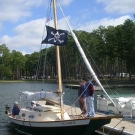
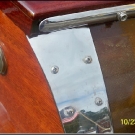
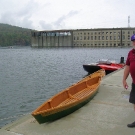
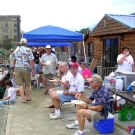

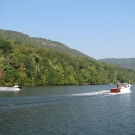
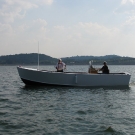

Yes, we ship our products all over the world! Our online shopping cart will provide you with several shipping options when you place items in your cart. You can also check postage prior to ordering as there is a link on the first page of the shopping cart to get an estimate.
Our plans are not available in metric, only imperial measurements as they have all been hand drawn since the early 1950’s. We have a helpful article with some conversion tables online that many find useful.
No. Our plans are all hand drawn and not in any computer format. They are printed on very large paper. The patterns are usually 36″ to 42″ wide and quite long–usually 6′ to 10′ or so. Remember, these are full size patterns for the frames of the boat.
We provide a bill of materials listing in our online catalog on the page detailing the design. This is the best way to determine cost to build because materials costs will vary depending on where you are located. We also have a page online that lists cost to build feedback from builders.
This is done by respacing the frames a proportional amount from the aft end of the stem to the transom. See our article for detailed instructions.
We don’t recommend changing the beam of a boat because this can completely change the boat’s performance. See our detailed explanation of what can and cannot be changed on a boat.
As for altering the cabin, if such changes don’t alter location and/or size of major weight items such as tanks or motors, they can usually be made at will.
Not recommended. Fasteners do not hold well in the edge-grain of plywood. It is also difficult to seal the edges of all the frames so that they will not begin to swell and crack.
We have a List of lumber suppliers on our site that may have a source, however, long sheets are not required. Standard 4′ x 8′ sheets can be joined using either a scarf joint or a butt block. We rarely use long sheets anymore; we normally use a butt block. Structurally, this is equal to or stronger than a full-length sheet if properly done. See our article on Joining plywood to make longer sheets for a description of making a scarf and butt joint.
First, you’re shopping in the wrong place. Building centers are great, but they don’t normally sell many low volume items. Go to a real lumberyard. Not all plans call out marine plywood. Small rowboats and other small designs frequently give ABX (exterior) as an option. The “AB” designation means that there are no open knots on the surfaces.
When marine is called for, it is usually only called out for planking; not for the transom, gussets, knees, stem, or breasthook. Marine is important when the plywood will be bent. Marine plywood has no voids running across the panel, exterior does. Picture a 1/4″ or 3/8″ panel (3 plies) with a 1/2″ gap running across the panel. This means that more than 1/3″ of the thickness is air. If the bend is particularly pronounced at this point or there is a lot of stress, it could fracture at the void.
So what do you do if you can’t get marine? That’s your call. If the boat you intend to build is a high speed boat that will take a lot of pounding, do you want to take the chance?
OPTIONS: If you live in Timbuktu, can’t get marine, choose the best ABX you can find (check edges for voids). Put the best sheets in the forward sections. If you have a choice, use marine if called for. For planking applications, AC is not desirable because of the open knots which allow water to enter the center plies. To properly fill the knots (epoxy fillers), is more work and expense than buying the proper material.
First, read above about “real lumberyards”. OPTIONS: Join shorter pieces. Make the joint in the aft section, where there is less bending. Use a scarf joint or butt joint backed with a butt block. Scarf joint: use a joint ratio of 1:8 to 1:12. Butt joint: Butt between frames backed up with material of the same thickness, from frame to frame. If there is any curve in the member, bend a temporary longer piece in position and plane the butt block to match the arc. If this is not done, a flat spot will result.
There are other types of wood that can be used. “Marine lumbers” have certain characteristics: glue-ability, hold fasteners well, resistant to rot, relatively strong. Other woods: Douglas-fir, long-leaf yellow pine (old growth), cypress. There are some eucalyptus (available in Australia) that are excellent for boatbuilding. Several cedars and spruces are good for small, lightweight, boats. We will not attempt to list all the woods that could be used (not that we could). Be reasonable about this. If you are going to build a small rowboat that won’t go out much, use another straight-grained hardwood. As long as it is well sealed, dry-rot should not be a problem.
Whenever you purchase wood for boatbuilding, look at the edges. If the grain runs parallel to the surfaces, it is less likely to break than wood where the grain runs diagonal to the surfaces. Straight-grained (boring looking) wood is always desirable for structural applications. If your boat is kept under cover, if you are really good about maintenance, keep a good paint job on the wood, if you don’t care if it lasts more than a year… you may not have to worry about rot.
Here are some comments from our Australian builders as to wood they are using:
“Riviera… The frames and stringers have been made from Nyatoh (Palaquium spp. and Payena spp.), an Indonesian hardwood commonly utilised for boat building in this part of the world.” – Andrew Tainsh, Perth, Western Australia
“Riviera… The frame is made of Blue Gum (Eucalyptus globulus) and Messmate, which are both local eucalypts. Both have similar strength, density and working properties to Mahogany,and have been used in boats here for many years.” – Craig Strike, Victoria, Australia
There are builders who use any number of woods that are not considered good boat building material, many never have problems with them; but we are boat designers, and will not recommend materials that we think are inferior. If you deviate from the materials list, be reasonable. If you are using inferior materials, just because they are cheaper, this is false economy.
This can be caused by over-drying of the wood or using material that has diagonal edge grain. If you are using “diagonal-grain” material, use it where it will not be stressed. Use parallel grain in the forward section.
OPTION: Most often longitudinals can be finessed into position by using boiling water. 1) Clamp the piece to the frames and pull the forward end of the piece toward the stem and tie in place. 2) Wrap the bending part with towels and pour on boiling water. 3) Allow to sit overnight. This will usually do it, but you can increase the tension and repeat if you feel it is necessary. You shouldn’t find it necessary to steam any piece on a Glen-L design.
Whether you are working with lumber or plywood, remember that you are working with organic materials, materials that may be old growth or new, may have had periods of rapid growth or slow, depending on climate. Why are you having problems when others don’t… lucky? Old-time carpenters look at the lumber they use, they don’t accept the pieces on the top of the pile. They look carefully for the characteristics that make them best suitable for the job they are doing. Buying your materials from someone who specializes in them allows you to take advantage of their knowledge and expertise, and can save you a lot of time and money.
Use the towels-boiling water-overnight treatment above. Put a piece of wood on either side of the pointy-end of the panel to spread the stress, clamp with a C-clamp, pull toward position, tie off with rope. This can be repeated if necessary.
This is an awkward question. The answer is, don’t find yourself in this position. Increasingly you will find scant plywood available. Scant is 1/32″ less than the nominal thickness. Why do they do this? To make more money. When you are purchasing plywood, just be aware that scant is out there. If you ask, you want “full thickness, not scant plywood”. Any “cure” for the problem after the plywood is installed will be “Mickey Mouse”.
Our system requires that you select a state, even outside the US. Choose the state of “International” from the drop-down list in the State field and you should be able to proceed.
greetings, I am looking at the 17′ sea kayak plans. I stand 6’0″ and 325 pounds. yes I know I am fat. but I keep trying to change that problem. what is the weight capacity on the 17′ sea kayak? I don’t want to build a boat that will sink just because I sat in it!. And how wide is the cockpit? Since I’m size 52 at the waist I just do not want to get stuck and send out for some kind of lube. or worse yet a saw of some kind. thanks for your time I am sure that more question will follow.
sincerely
Gregory Leak
Gregory, the Sea Kayak can hold at least 325# but this boat has a beam of 24″ and the cockpit will be smaller than that. I would suggest you consider some type of row boat such as the Sissy Do.
Is the flying saucer design suitable for jet propulsion (sea doo, Kawasaki,etc.) or would it require heavy modifications?
Yes, you could use a jet on the Flying Saucer and yes, there would be a lot of modifications. We have a section on our Forum for builders altering our designs for jet power: http://www.glen-l.com/phpBB2/viewforum.php?f=23
I have been looking at Glen L plans for quite a while. I would like to purchase plans soon to begin building, but I have a question:
Is there a way to have Glen L modify a set of plans? If, so how much would this cost. I am willing to pay the extra to get what I want. Looking at the Little Hunk design, is it possible to modify the design to have the same type of hull as Chunky Dory or V-Dory? My preference would be a hull like Chunky Dory, but a V-Dory type hull would be something I would consider. I realize that I could just build Chunky Dory as a 20′ boat, but I already own a trailer that used to carry a 18′ Stingray Bowrider. I would appreciate any feedback, thank you
Tollie, We don’t do any custom design work, but many of our builders modify our boats to suit their needs. However, making changes to the bottom of the hull isn’t recommended. See our article on changing plans: http://www.glen-l.com/changing-plans/
Thank you Gayle, for your reply and information. I’ll give it some more thought. I am looking forward to being able to begin building my first boat.
Currently I’m trying to decide to go with the Monaco or the Biscayne. Plus educating myself as best I can before I dive in. My question has to do with the planking. Reading on your site, that it’s possible to use lower quality of wood on the first layers and use mahogany on the last layer. What wood would you recommend for the beginning layers? Spruce or similar or 1/8 ply.
Jim, we don’t recommend “lower quality wood”, just the option of plywood or lumber. Either material should still be of the quality used in a marine application. Our book, Boatbuilding with Plywood” goes into detail as to wood species for building boats. Also, the bill of materials for each of our designs online provides some material options too.
I recently picked up a 1971 mercury 20hp my intent was to put it on my 8 foot tiny titan hydroplane I didn’t realizing that I needed a short shaft. Can I put a long shaft on my hydroplane?
I think I answered you via email. You can use a long shaft but it may affect performance with the extra drag from the longer shaft.
I have plans for the Belle isle 23 but note the engine stringers are 26″apart. Can this distance be reduced to accommodate a diesel engine i would wish to fit, without altering the integrity of the build and strength of hull overall
Derek, the spacing of the motor stringers needs to match the motor you are using, so yes, you can change that.